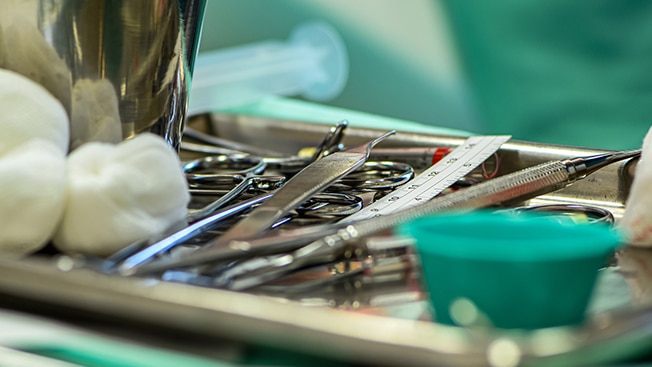Your prostate specific antigen (PSA) blood test results have come back abnormal, rising to a level possibly indicating prostate cancer. Or, maybe your physician felt something suspicious during a digital rectal exam. Now what?
Any man, who’s been in this scenario, knows that their physician will likely recommend a prostate biopsy. A prostate biopsy helps determines if prostate cancer is present. If the biopsy identifies cancer, decisions will be made as to which treatment option is appropriate for the type and stage of cancer.
Tell a man he needs a biopsy of his prostate, and you’ll see a wide range of emotions. Some men react stoically, while others display a wide-eyed look of alarm and dread. Just hearing the word “biopsy” can strike fear in most people, whether related to prostate cancer or another condition. While these procedures can seem scary and unsettling, understanding why they are done and what to expect helps alleviate fears or concerns men may have.
What is a prostate biopsy?
A biopsy is a procedure that usually involves taking a sample of body tissue examined under a microscope. Practically all cancers will require some sort of biopsy to confirm a diagnosis and determine what steps to take for the best treatment. A prostate biopsy takes only ten to fifteen minutes and is often done in the urologist’s office.
What men can expect during a prostate biopsy
Naturally, men have concerns over getting a biopsy, especially in private and intimate parts of their bodies. As you’d probably guess, one of the biggest concerns is pain. Of course, everyone has their personal pain tolerance. Regardless, I reassure men they will be kept comfortable as possible, with little if any pain.
To make the prostate biopsy as smooth and pain-free as possible, certain steps need to take place before, during, and after the procedure. One is for you and your doctor to discuss any herbal supplements, or vitamin/mineral supplements you take and if you have had any allergic reactions to anesthesia.
Next, your doctor should review your list of medications and determine whether any could affect the procedure. Medications I advise men to stop taking seven to ten days beforehand are aspirin and anticoagulants (aka blood thinners) such as warfarin, dabigatran (Pradaxa), edoxaban (Savaysa), rivaroxaban (Xarelto), and apixaban (Eliquis). These drugs reduce the blood’s ability to clot, and I will need to weigh the chance of bleeding against temporarily stopping these medications that prevent heart problems or stroke.
So, what exactly happens when you need a prostate biopsy? Here’s the rundown:
- At home, do a cleansing enema before your appointment. This will flush out your colon and reduce your risk of infection.
- If your urologist has prescribed antibiotics, take them a half-hour to an hour before your procedure. Although the risk is actually very low, these can help prevent infection.
- During the biopsy, you’ll be given medicine to numb the nerves that supply your prostate. A probe will be placed in the rectum to numb the area with an injection of a local anesthetic.
- You should only feel some pressure but no sharp pain while this part of the procedure occurs. This probe also uses sound waves to help accurately direct the numbing agent and the biopsy needle.
- After the anesthetic is delivered, the thin, hollow, spring-loaded biopsy needle is inserted into your prostate gland. This needle will take eight to eighteen prostate tissue samples from different areas of the prostate.
- Each time the needle is inserted and removed, it pulls out a small amount of prostate tissue.
Aside from the traditional prostate biopsy just described, other types of prostate biopsies include:
- Transurethral biopsy – To access the prostate, a long, thin tube equipped with a camera, will be passed through the opening (urethra) of the penis.
- Transperineal biopsy – This type of prostate biopsy involves making a small incision in the skin area (perineum) between the anus and the scrotum. A biopsy needle will be inserted through the cut and the prostate to draw out a sample tissue.
- MRI fusion biopsy – This relatively new type of biopsy takes a multiparametric MRI image of the prostate gland. It then is fused with live ultrasound image, allowing doctors to identify suspicious areas where the needle biopsy should take a sample. This real-time 3D image provides such clarity and precision that doctors can eliminate the need to take multiple random biopsies, which traditional prostate biopsies rely on. Even better, it helps find aggressive tumors that may have otherwise been missed. MRI fusion biopsy simply provides a more accurate diagnosis helping identify the best type of cancer treatment for each patient without overtreating him.
What happens after a prostate biopsy?
After any prostate biopsy, you will be advised the following:
- Drink plenty of water
- Avoid heavy lifting for twenty-four hours
- Avoid straining during bowel movements for forty-eight hours
You can expect short-term side effects such as soreness, blood in your urine, light rectal bleeding, and blood in your semen. Contact your doctor immediately of you experience of the following symptoms:
- Difficulty or pain while urinating
- Heavy or ongoing bleeding
- Increasing pain, swelling, fever
- Penile discharge
Dr. David Samadi is the Director of Men’s Health and Urologic Oncology at St. Francis Hospital in Long Island. He’s a renowned and highly successful board certified Urologic Oncologist Expert and Robotic Surgeon in New York City, regarded as one of the leading prostate surgeons in the U.S., with a vast expertise in prostate cancer treatment and Robotic-Assisted Laparoscopic Prostatectomy. Dr. Samadi is a medical contributor to NewsMax TV and is also the author of The Ultimate MANual, Dr. Samadi’s Guide to Men’s Health and Wellness, available online both on Amazon and Barnes & Noble. Visit Dr. Samadi’s websites at robotic oncolo gy and prostate cancer 911.


